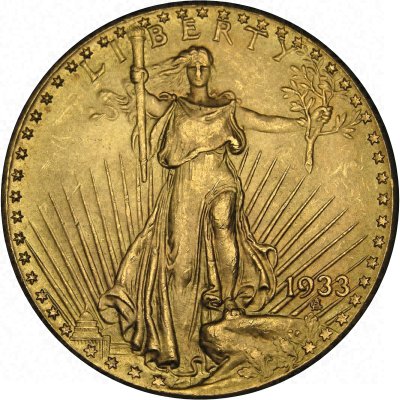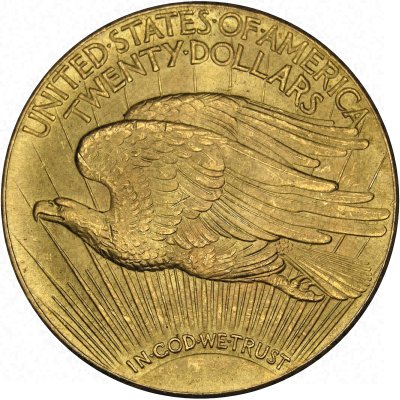
US Government Tries to Grab 10 x $7.5 Million Gold CoinsAfter a previous U.S. Government attempt to seize a rare ex-King Farouk collection 1933 American gold $20 double eagle coin from a UK dealer, they are now trying to dislodge another 10 in private ownership, probably only to destroy them. There may be many more out there.Israel SwittA few years ago, the family of Israel Switt discovered 10 extremely rare 1933 double eagles, one of the world's most famous coin rarities in a safe deposit box. The family contacted the US Treasury Department in order to authenticate the coins so that they could sell them. However, the US Government confiscated them instead, claiming to be the true owners of these coins and is now holding them as the family pursues a civil suit to get them back.
Gold Theft?445,500 Double Eagles were minted in 1933. However, it is generally believed that none were ever officially released for circulation, as the president, Franklin Roosevelt, signed an executive order which took America off the gold standard and recalled gold coins in return for paper money. Subsequently, most of the coins were melted down. The Treasury donated two coins to the Smithsonian Institute, but other coins also escaped the melting pot, for reasons which the US Government says was not sanctioned by them.The Farouk Double EagleIn 2001, a British coin dealer, Stephen Fenton, was arrested in New York in a sting operation when he tried to sell a double eagle that he claimed had once belonged to King Farouk of Egypt. Criminal charges were eventually dropped against Fenton, but Government held onto the coin arguing that the coin belonged to them. The case was settled however, when the Government agreed to split proceeds of the sale at auction with Mr Fenton, plus $20 to US Government for monetising the coin. The coin was then sold at auction in 2002 at Sotheby's for a record-breaking $7,590,020.00.Israel SwittA few years later, the heirs of Israel Switt, a New York Jeweller who died in 1990, discovered 10 Double Eagles in a safety deposit box that had once belonged to Switt. The family contacted the US Treasury in order to get the coins authenticated with a view to selling them, hoping for a similar deal in which the proceeds of any sale would be split between the US Government. However, the US Government instead claimed ownership of the coins and confiscated them, and is not so far offering the same deal that it offered to Stephen Fenton.Is the US Government Claim to Ownership of the Coins Reasonable?The US Government claims that Israel Switt obtained the coins illegally, and that his heirs have no claim on property that was illegally obtained by him. Israel Switt was a personal friend of US Mint Cashier George McCann, and it seems likely that George McCann probably swapped $20 gold pieces of earlier years for the 1933 specimens that Israel Switt came to possess. Nine of these were sold on some years later and subsequently confiscated by the US Secret Service. Israel Switt then apparently claimed that he did not have any more left. Switt could not be prosecuted for the alleged theft because the statute of limitations had expired, but the US Government still maintains that it is the rightful owner of the coins.Our OpinionWe believe that the US Government is being heavy-handed, not to mention inconsistent in its treatment of Switt's heirs. If Fenton was entitled to half a share in the proceeds of the sale of the Farouk Double Eagle, then why aren't Switt's heirs? Claiming that the coins were stolen is also a bit dubious. They were probably swapped, not stolen by Switt, with the cooperation of a Mint official. At the time that they were swapped (a common practice with mints the world over at the time) the 1933 Double Eagle was not a rarity, they were just $20 gold pieces, and the Treasury would not have lost out when all the double eagles they had in storage were melted down.The US Government's refusal to offer Switt's family the same deal that they gave to Stephen Fenton is also unfair. Having agreed to settle in Fenton's case, their actions against Switt's heirs is very inconsistent and unjust. By agreeing to settle with Fenton, the US Government set a precedent which they are not willing to adhere to in the case of Switt's family. Hopefully, a US Court will agree with us and allow Switt's heirs to sell their property and share the proceeds with the Government. It would be even better if the Government was forced to return the coins and pay the family's legal bills for forcing them to take this action in order to recover their property. Legal GapSome in the numismatic world have advanced an argument that Switt could have legally obtained the 1933 coins when he was exchanging gold bullion for coins. Although the Mint records apparently show that no 1933 Double Eagles were issued, there were allegedly three weeks in March 1933 when new Double Eagles could possibly have been legally obtained. The Mint began striking double eagles on March 15 and Roosevelt's Executive Order to ban them wasn't finalized until April 5. On March 6, 1933, the Secretary of the Treasury ordered the Director of the Mint to pay gold only under license issued by the Secretary, and the United States Mint Cashier's daily statements do not reflect that any 1933 Double Eagles were paid out.
Update - July 2011Everybody LosesA jury in Philidelphia has found in favour of the US Government. However, the case is subject to a further appeal to a higher federal court. Watch this space.
U.S.A. Gold Coins
U.S. Gold $20 Double Eagles |

1933 USA Gold $20 Double Eagle
Reverse of 1933 USA Gold $20 Double Eagle |